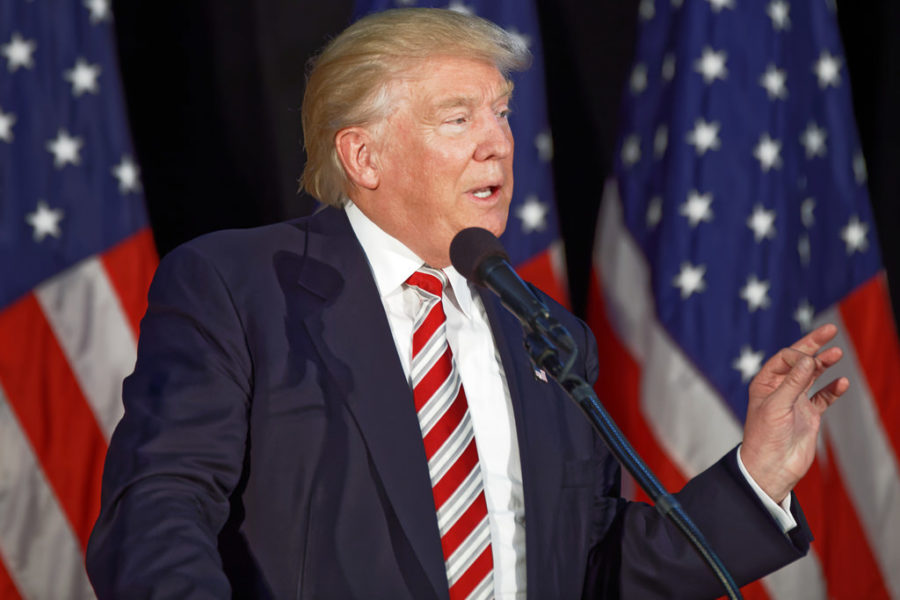Trouble in Paradise: Tensions Between the President and Congress
It’s no secret that President Trump and Congress aren’t best friends. From Twitter to mainstream news, the different scandals that have happened over the current presidential term have become evident to all. With the newly elected Congress sworn in January, tensions have risen.
It all started during the process of the 2016 election.
On July 21, 2016 Donald J. Trump acquired the title as the republican nominee for the 2016 presidential election. Upon this acceptance, Trump gave a speech lasting just under an hour and twenty minutes, highlighting everything he hoped to achieve in his presidency.
A few of the most memorable problems he wanted to manage included: violence in America, the economy, immigration, trade and the appointment of Supreme Court justices. He also hoped to remove Obamacare, provide more support to the military and reduce taxes.
He mainly focused and ran on the idea of “building a wall” across the southern border, to ensure safety for his fellow American citizens, and control over all crimes associated with the border.
Although these problems he wished to solve seemed ideal at the time, Congress began causing unease soon after the president was elected.
On November 8, 2016, Donald J. Trump was elected as the 45th president of the United States.
Less than two months later, on January 20, 2017, Trump was sworn into office and gave his inaugural address.
In his speech, he promised, “Every decision on trade, on taxes, on immigration, on foreign affairs, will be made to benefit American workers and American families.”
“[Americans] must protect our borders from the ravages of other countries making our products, stealing our companies, and destroying our jobs,” he said. “Protection will lead to great prosperity and strength.”
According to The New York Times, Trump’s speech was about reaching out and uniting the country. He appealed to both democrats and republicans, in hope that specific political parties wouldn’t rule the government; he wanted the government to be completely ruled by the people.
Quite the opposite happened, however.
Just days after being elected into office, on January 25, 2017, President Trump began border security and immigration enforcement improvements. He made an Executive Order, deploying all means to secure the southern border, preventing illegal immigration into the United States.
On the same day, he also made an Executive Order to enhance public safety within the United States. This order’s purpose was to enforce the current immigration laws in place, ensuring the safety of American citizens.
Following the establishment of these presidential acts, democrats in Congress began their dispute against the idea of keeping immigrants out.
According to GOP, the democrats in Congress take opposition to the issue of border security, specifically to take a stance against Donald Trump’s republican views.
In 2006, just ten years before Donald Trump’s election, democrats in Congress supported a bill to build 700 miles of wall across the southern border. The purpose of the bill titled The Secure Fence Act of 2006 was to minimize the number of illegal immigrants crossing over the border, and put an end to drug trafficking across the border.
Other democrats argue that allowing immigrants to enter will expose America to a cultural explosion, leading to a booming economy and much more, which democrat Hillary Clinton summarized in the above video.
What this has led up to:
Today, however, everything seems to be strictly political. Although several democrats once had the same ideals as republicans on the issue of border security, democrats and republicans now challenge each other in and out of Congress.
According to senior Jordan Hubbard, the biggest problem between Congress and President Trump is, “the difference in political parties. Things have become way too political,” Hubbard said. “It’s one party versus the other at this point.”
Most tensions between Congress and President Donald Trump began during the process of the 2018 midterm elections.
Prior to the Midterm elections, the republicans held complete control in Congress, with the majority number of seats in both the House and the Senate.
According to TIME, the democrats hoped to achieve a “Blue Wave” due to unfavorable results towards republicans in polls and data collections taken before. Donald Trump, however, tried making the election about him, as keeping seats in Congress would help him pass almost anything desired.
The results, according to The Washington Post, show that the democrats won 235 seats, while the republicans won 199. Democrats took control of the House, while republicans took control of the Senate.
Although he lost control of Congress through this election for the democrats, President Trump stayed sharp, tweeting:
“Tremendous success tonight. Thank you to all!”
House Minority Leader Nancy Pelosi also expressed her satisfaction in the results, stating:
“Thanks to [democratic voters], tomorrow will be a new day in America.”
Democrats took victory on the night of the midterm election, causing problems even before they initially took their positions.
Still pushing to “build the wall”, Donald Trump urged Congress to allow him to do what he initially ran on for president: border protection.
When Congress and President Trump were unable to agree on a spending plan of $5 billion for Trump’s border wall on December 1, 2018, the government partially shutdown. All government employees not deemed essential during the shutdown were forced to work without pay, causing financial problems. Still, both Congress and President Trump remained relentless, refusing to work with one another, and kept the government shutdown.
The government shutdown lasted an arduous 35 days, finally reopening on January 25, 2019 on a tentative deal between President Trump and Congress. The 2018-2019 partial government shutdown was the longest ever.
Using the #ShutdownStories on Twitter, people expressed the demanding situations they endured. One woman tweeted the following message:
“My husband is active duty Coast Guard. Everyone thinks the military is getting paid during the shutdown, but the Coast Guard is facing no pay on the 1st due to being DHS and not DoD. We live in NYC, pay over $2K/month in rent, have a toddler and one on the way.”
Some federal workers even went as far as suing the federal government for forcing work without pay. Government employees missed two paychecks during this shutdown.
This harmful situation for several was caused simply because Donald Trump and Congress were unable to agree.
In response to the government shutdown, Hubbard said, “I think [this is] the way government’s supposed to work. It happens.”
Unsatisfied after the tentative agreement between Congress and himself, President Trump declared a national emergency in order to obtain the funds needed to build the border wall.
Contrary to popular belief, Donald Trump does have the ability to declare a national emergency, seeing as a president can proclaim one without reasoning.
President Trump argues that his reasoning for this declaration is because Congress refuses to work with him on any issues.
When asked if Congress holds too much power, Hubbard responded, “I think all of the branches have exceeded the power that they were originally supposed to have, but that’s not necessarily a bad thing.”
Where things stand now:
Still, tensions live on, and will continue to until settlements are made. The national emergency is still ongoing (A/O 26 Feb. 2019).
According to Hubbard, in order to reach peace in government, “compromises must be made on both sides.”
Congress and the president must be willing to work together in order to achieve what they both need.
In order to ease tensions, Congress and the president need to collaborate.
For more information on the divide between democrats and republicans, click here.
For more information about the tragedies that have taken place at the border wall, click here.

Hello there! My name is Leilani and I'm a Copy Editor for the Jetsream, and a senior at AAHS. I'm currently part of the Orchestra playing violin, and the...








